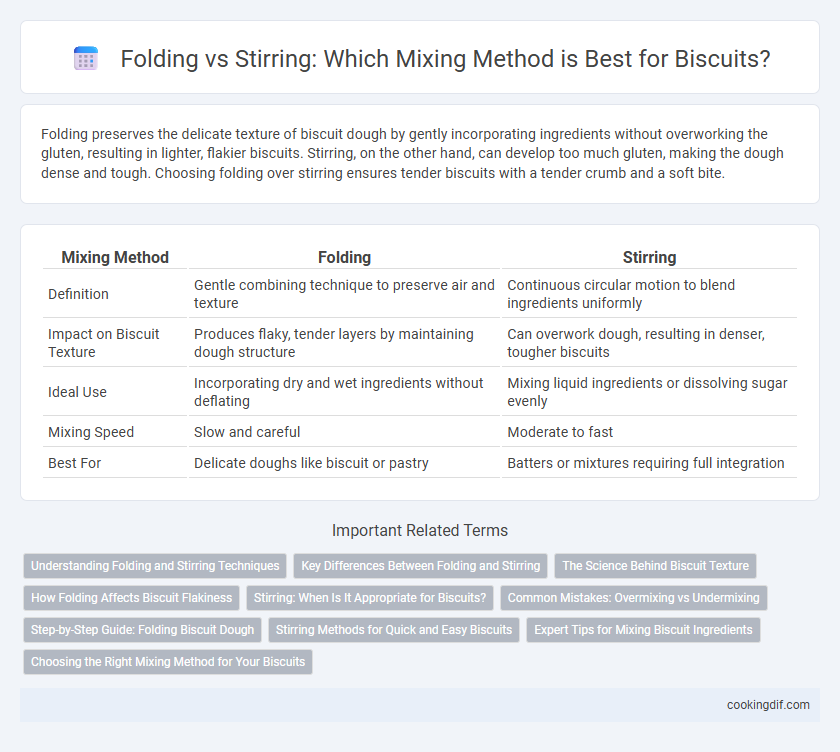Folding preserves the delicate texture of biscuit dough by gently incorporating ingredients without overworking the gluten, resulting in lighter, flakier biscuits. Stirring, on the other hand, can develop too much gluten, making the dough dense and tough. Choosing folding over stirring ensures tender biscuits with a tender crumb and a soft bite.
Table of Comparison
| Mixing Method | Folding | Stirring |
|---|---|---|
| Definition | Gentle combining technique to preserve air and texture | Continuous circular motion to blend ingredients uniformly |
| Impact on Biscuit Texture | Produces flaky, tender layers by maintaining dough structure | Can overwork dough, resulting in denser, tougher biscuits |
| Ideal Use | Incorporating dry and wet ingredients without deflating | Mixing liquid ingredients or dissolving sugar evenly |
| Mixing Speed | Slow and careful | Moderate to fast |
| Best For | Delicate doughs like biscuit or pastry | Batters or mixtures requiring full integration |
Understanding Folding and Stirring Techniques
Folding involves gently combining ingredients by lifting and turning the mixture to maintain airiness, essential for delicate biscuit dough to ensure a light, flaky texture. Stirring uses a more vigorous circular motion to evenly mix ingredients but can develop gluten, potentially resulting in denser biscuits. Mastering folding prevents overmixing and preserves the dough's tenderness, while stirring suits recipes requiring thorough ingredient integration.
Key Differences Between Folding and Stirring
Folding gently combines ingredients to maintain air and structure, crucial for delicate biscuit doughs that require fluffiness. Stirring involves vigorous motion, promoting thorough mixing but risking overworking gluten, which can lead to dense, tough biscuits. Choosing folding over stirring preserves the tender, flaky texture essential for high-quality biscuits.
The Science Behind Biscuit Texture
Folding incorporates air gently into biscuit dough, preserving gluten structure and resulting in a flaky, tender texture. Stirring activates gluten development more intensely, producing denser, chewier biscuits by strengthening the dough matrix. Understanding the balance between these methods is crucial for achieving the desired crumb and mouthfeel in biscuit baking.
How Folding Affects Biscuit Flakiness
Folding preserves the distinct layers of fat and flour within the biscuit dough, which helps create a flaky texture by preventing overworking gluten. Stirring can cause excessive gluten development, leading to denser biscuits with less rise and flakiness. The folding technique carefully incorporates ingredients while maintaining dough structure, essential for tender, flaky biscuits.
Stirring: When Is It Appropriate for Biscuits?
Stirring is appropriate for biscuits when the dough requires a gentler mixing method to avoid overdeveloping gluten, which can result in tough, dense biscuits. This method is ideal for recipes with softer dough or when incorporating liquid ingredients evenly without disrupting the delicate texture. Stirring helps maintain a tender crumb by combining ingredients just until moistened, ensuring light and flaky biscuits.
Common Mistakes: Overmixing vs Undermixing
Overmixing biscuit dough often results in tough, dense biscuits due to gluten overdevelopment, while undermixing can lead to uneven texture and poor rise. Folding the dough gently helps maintain flakiness and prevents the loss of trapped air, whereas stirring aggressively risks overworking the dough. Ensuring the right balance by minimally folding until ingredients are just combined optimizes biscuit tenderness and crumb.
Step-by-Step Guide: Folding Biscuit Dough
Folding biscuit dough preserves the integrity of the flaky layers by carefully incorporating ingredients without overworking the dough. Begin by adding the wet ingredients to the dry, then use a spatula to gently lift and fold the mixture from the bottom up, rotating the bowl as you go. Avoid vigorous stirring, which can develop gluten, resulting in tough biscuits instead of light, tender layers.
Stirring Methods for Quick and Easy Biscuits
Stirring methods for quick and easy biscuits involve gently combining ingredients to avoid overworking the dough, resulting in tender and flaky textures. This technique efficiently incorporates flour, fat, and liquid, promoting even hydration without activating too much gluten. Stirring ensures a soft biscuit crumb with minimal effort, making it ideal for fast preparation and consistent baking outcomes.
Expert Tips for Mixing Biscuit Ingredients
Folding preserves the delicate crumb structure of biscuits by gently combining flour and wet ingredients, preventing gluten overdevelopment that can result in tough textures. Stirring vigorously can lead to uneven gluten formation, causing dense, heavy biscuits rather than light, flaky layers. Expert bakers recommend folding just until the ingredients are incorporated to maintain the ideal tender crumb and perfect rise.
Choosing the Right Mixing Method for Your Biscuits
Folding preserves the delicate layers and prevents overworking the dough, resulting in flaky, tender biscuits with distinct texture. Stirring mixes ingredients more thoroughly but can develop gluten too much, leading to denser, tougher biscuits. Choosing folding over stirring is essential for achieving light, airy biscuits with optimal rise and softness.
Folding vs Stirring for mixing method Infographic

 cookingdif.com
cookingdif.com